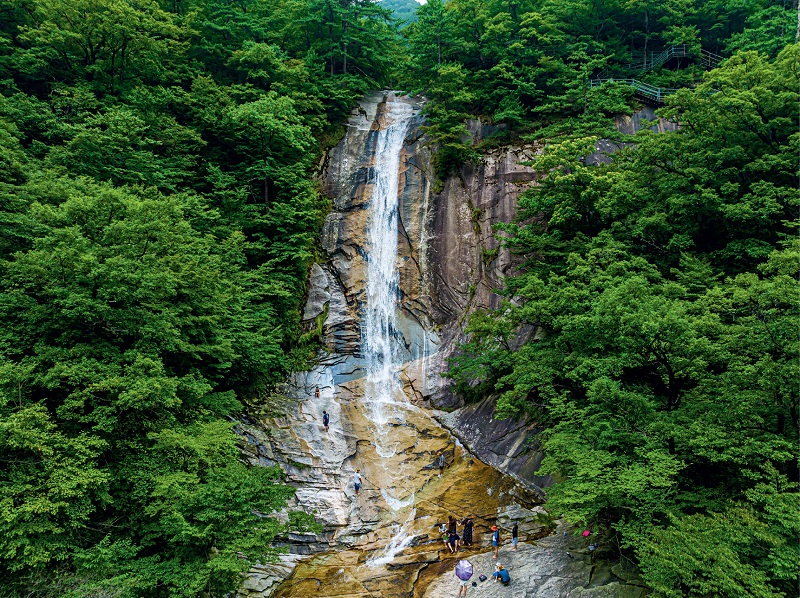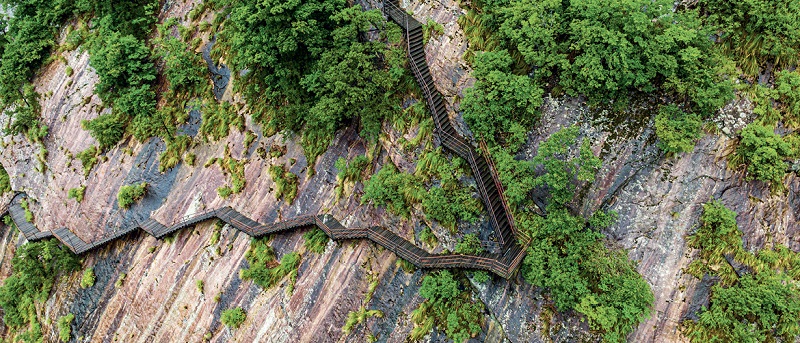The Tiantangzhai Scenic Area is located in Jinzhai County of east China’s Anhui Province. It is part of the Dabie Mountains, the watershed of China’s north-south water system where water on the north of the mountain flows northward into the Huaihe River, while water on the south of the mountain flows southward into the Yangtze River. From the highest point of Tiantangzhai, one can get breathtaking views of the plains in the north and the south, as well as the majestic peaks surrounding them.
With a total area stretching 120 square kilometers, the Tiantangzhai Scenic Area is now a designated national 5A tourist attraction, a national nature reserve, and a national forest park. It has 25 peaks at an elevation of over 1,000 meters. The forest coverage rate here is as high as 96.5 percent, while also featuring the only primitive forest in east China. There are also a number of pools and waterfalls as well as grotesque pines and rocks. In ancient times, it was given the name “the first pass in the southeastern Yangtze River region” on account of its strategic position. In addition, it has a rich history, documenting the footprints of human civilization.

Jade Cascading Falls looks like a jade belt lying in the greenery of Tiantangzhai.
Waterfall Cluster Scenic Area
The Waterfall Cluster Scenic Area is the most popular attraction of Tiantangzhai, covering an area of 32 square kilometers. The dense forests here have rich water features, and the main scenic spots in the area include five year-round waterfalls — Nine Shadows Falls, Lover Falls, Jade Cascading Falls, Lady Falls, and Silver Bow Falls — and granite peaks.
After trekking on the trail for a while, tourists begin to hear the din of the thundering sound of the waterfall near a turn, after which they arrive at the first waterfall among the cluster — Nine Shadows Falls. It is 71 meters high with a width of eight meters and falls into a 30-square-meter pool. The waterfall does not dry up in the wintertime, and has a heavier flow of water during the rainy season, presenting a majestic scene to behold.
Not far away is Lover Falls, about 15 meters wide and 44 meters high. It is the shortest one among the five major waterfalls, featuring a gentle flow cascading down after several stairs. The pleasant ambience that the waterfall exudes evokes comparisons with the gentle whispering of lovers. Visitors can take a short break here as it is still an hour away from the next waterfall attraction.
The third waterfall is Jade Cascading Falls with a vertical height of 62 meters and a width of 12 meters. The jagged cliff behind the water curtain is lavender-colored and slightly tilted while the flow of water on it like rolling beads of jade, or a thin sheet of silk cascading down smoothly to the large stone slab at the bottom. Standing here, visitors can immerse themselves in the stunning nature at all sides. Venturing further, the first stone stairway on the right hand leads uphill to a pond, called Yaochi, which is an oval-shaped cave about one meter deep. It has been formed by erosion caused by the unceasing flow of water and sands taking place in a crevice between two rocks.
The fourth waterfall in the waterfall cluster is Lady Falls, which is 57 meters high and 10-16 meters wide. Water flows down the stone surface and into a crystal-clear pool. The shape of the waterfall features three wide curves and two narrow curves, resembling a girl in a long dress dancing in the depths of the forest. The next attraction is the Silver Bow Falls, with a height of 68 meters and a width around 11-15 meters. The waterfall is like a silver bow ready to dart into a deep pool of about 100 square meters. Finishing the tour of waterfalls, tourists can choose to return to Jade Cascading Falls next to the cable service station and head to Paradise Top, the highest peak of Tiantangzhai.
Paradise Peak — also the second highest peak of the Dabie Mountains — is about 1,729 meters above sea level. The main peak is shrouded by clouds year-round. Here tourists can see the landmark dividing line for the provinces of Anhui and Hubei. According to historical records, the first beacon tower in Tiantangzhai was built here during the State of Chu reign (770-223 BC). Nowadays, there is a replica of the tower here.

Tiantangzhai is blanketed underneath a layer of snow.

White Horse Grand Canyon
White Horse Grand Canyon is also a must-visit scenic area in Tiantangzhai, which is one of the main origins of the Huaihe River. The U-shaped canyon is 6,000 meters long, with a wide floor and steep cliffs on both sides. The exposed rock layers at the bottom of the valley are about 2.5 billion years old. It is home to liriodendron chinense, sandalwood, hovenia dulcis and other rare plants, as well as rare animals like the Chinese giant salamander and the hairy-fronted muntjac. The canyon is famous for its various beautiful water bodies, strange rocks, and stunning geological landscapes.
The main peak of the canyon, White Horse Peak, stands 1,480 meters above sea level. Its west side is a bare cliff, on which is built a 3,366 meter-long trestle with a vertical height of nearly 800 meters, leading to the top of the peak. However, it is an extremely thrilling journey, as the trestle is mid-air and attached to the cliff on only one side. Paved by special wooden planks, it zigzags up to the top. Walking on the almost 90-degree vertical cliffs is not for the faint of heart. But at the highest spot of the trestle, visitors can look down at the mountains and take in the mesmerizing majesty of the Dabie Mountains, and get a glimpse of the vibrant life of Tiantangzhai.

The White Horse Peak Trail is built along a steep cliff and hangs in the air, with a total length of 3,366 meters and a vertical height of nearly 800 meters.
Historical Legacies
Evidence shows that the first military fortress and the first beacon tower in Tiantangzhai were built by the State of Chu in the Spring and Autumn Period (770-476 BC). The great patriotic poet Qu Yuan (340-278 BC) crossed the Dabie Mountains, worrying about his state and its people along the way. When he passed through Tiantangzhai, he was so concerned that he wrote the classic poem “Heavenly Questions.” In honor of Qu Yuan, local people named a giant boulder shaped like a man as “Qu Yuan Questioning Heaven,” hoping to keep alive the memory of his patriotic spirit and pass it on to the next generations.
Because of its geological location, all dynasties regarded Tiantangzhai as a strategic place. In contemporary times, the Red Army led by the Communist Party of China, the guerrillas against Japanese invasion, the New Fourth Army, and the People’s Liberation Army all fought here. Tiantangzhai was also an important part of the Hubei-Henan-Anhui Revolutionary Base during the Agrarian Revolutionary War (1927-1937). These traits make Tiantangzhai not only a phenomenal scenic spot to enjoy, but also a place of historical significance.